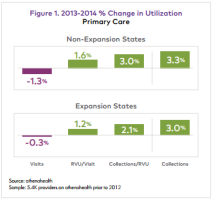 The Robert Wood Johnson Foundation and athenahealth publish ongoing analysis that examines how the Affordable Care Act (ACA) is affecting physicians. Over the past 18 months, the researchers team have monitored the impact of ACA legislation on approximately 20,000 physicians using athenahealth software that was implemented prior to 2012.
The Robert Wood Johnson Foundation and athenahealth publish ongoing analysis that examines how the Affordable Care Act (ACA) is affecting physicians. Over the past 18 months, the researchers team have monitored the impact of ACA legislation on approximately 20,000 physicians using athenahealth software that was implemented prior to 2012.
According to the latest data, physician practice collections have increased by 3.3% in states that didn’t expand Medicaid and 4% for surgeons. In states that did expand Medicaid, it was up 3% for primary care doctors and 2% for surgeons. The research is detailed on this ACA View Research Brief: Physician Practice Economics Under Coverage Expansion.
Key Findings from the ACA View research:
- In non-expansion states, privately insured individuals ages 41–64 drove 57.1 percent of the increase in primary care provider (PCP) revenues. Medicare patients drove 41.4 percent of the increase.
- In expansion states, Medicaid patients ages 41–64 drove 46.0 percent of the increase in PCP revenues. Medicare patients drove 39.4 percent of the increase.
- Privately-insured patients ages 41–64 were responsible for 51.1 percent of the revenue increase for surgeons in non-expansion states while Medicaid patients in the same age group accounted for 72.9 percent of the increase in expansion states.
According to this article in Forbes, Obamacare Has Given Doctors A 3% Pay Raise, while physician office visits have remained flat, expansion of health benefit coverage means an increase in the volume of more complex medical cases, making up for lost revenues. From Forbes: “Under new models of care such as patient-centered medical homes and accountable care organizations, industry analysts say it would make sense for primary care doctors to be seeing more complex cases. In these models, it’s common for primary care doctors to work as a quarterback of sorts in a team-based approach to medical treatment.”
The RWJF researchers conclude that overall, the data suggests “coverage expansion provisions of the ACA have not had a negative financial effect on medical practices. An increase in reimbursement rates has offset a slight reduction in visits to PCPs, while surgeons in our sample are seeing more patients. Of course, the fortunes of individual physicians and practices vary widely.”
